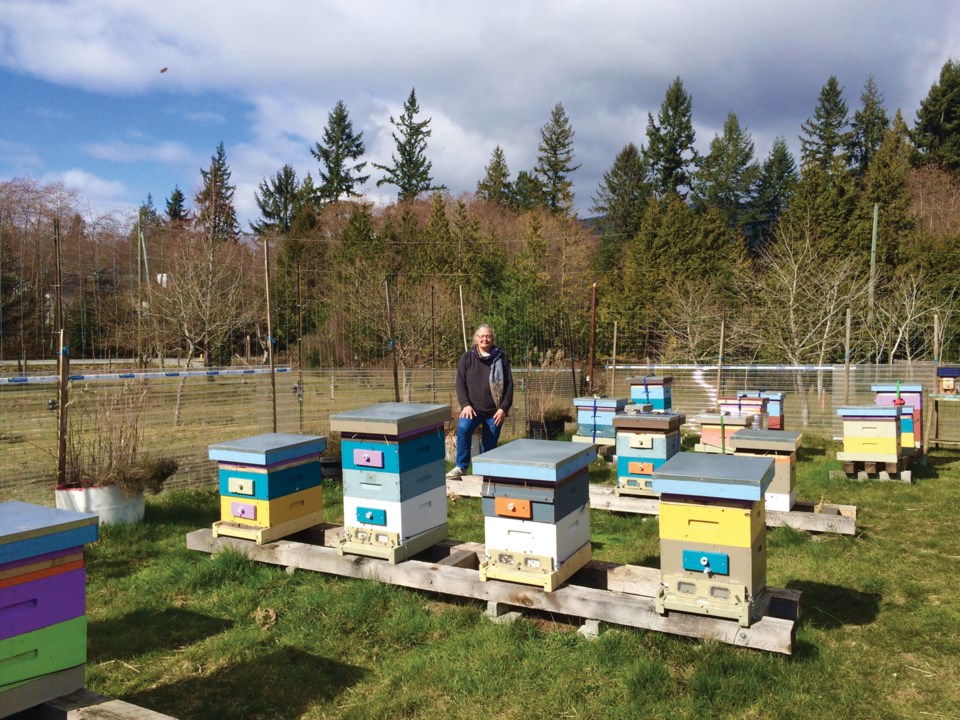Picture a sunny day and 19 beehives behind a tall wire fence in an attractive field on the Sunshine Coast. Imagine speaking with a beekeeper (keeping six-plus feet apart!) about these fascinating flying pollinators who have evolved over 120 million years. That day, we chatted across different rows of hives with the bees buzzing busily around their doorsteps, doing their intricate dances for each other. I felt fortunate for a glimpse into the magical world of the beekeeper, as I was ushered through the gate and into the world of Kathleen Suddes.
Suddes completed her Bee Master program, is a certified beekeeping instructor, and is on the board of the 39-member local bee club. After five years of apprenticing with Martin Cook, she took over Roberts Creek Honey in 2015.
Suddes is passionate about bees, calling them “smart, sophisticated super organisms.” She has 10 locations between Langdale and Wilson Creek where she sets the hives and is currently moving many of the hives from their “overwintering” spots. She doesn’t keep too many in one location, given that there can be 60,000 in a mature colony. Her husband helps with making much of the hive equipment but the frames and the supers are best purchased. Honeybees only sting if their hive is being threatened (they die after they’ve stung) and she says “they can get crabby, especially if the weather is turning and it’s about to rain, but they love the sun.”
She invited me to close my eyes and listen to the constant “hum” – very therapeutic.
Suddes told me that in spring there are many flowers, like wild cherry and various berries, so there’s excellent nectar flow. “Bees love dandelions, heather, salmonberries, and all maple trees are favourites,” she said.
“Blackberry is our main nectar flow in early summer. Anything that produces a seed, vegetable, fruit or nut is bee food.”
Salal blooms in late spring, but fall can be a hard time for bees as there are fewer flowers; she suggests to plant nectar sources for August onwards – bee balm, poppies, Joe pye, asters, goldenrod, and herbs are all good choices.
When I asked her about providing water for bees, she said to be careful – it’s easy to drown bees as they breathe through openings on their sides. If setting out water, use gravel “that creates safe footage, otherwise they fall in and can drown.” Bees cannot swim even a short distance.
We discussed the problem of pesticides, fungicides and glysophate, so harmful to bees (and other insects) but she said some very clean honey can be produced in cities, as so many have banned pesticide use. Suddes encourages people to buy only 100 per cent pure Canadian honey.
Sunshine Coast hives produce on average 60 to 75 pounds per year of the sweet stuff, while on the Prairies a hive can produce 300 pounds due to their expansive fields.
Beekeeping is very labour intensive and not for the faint of heart – and although winter is Suddes’ downtime, there is still a lot of work to be done in repairing and maintenance on the hives. There is a free online course through the province for those interested in learning more about these wonderful helpers, or you can contact the Sunshine Coast Beekeepers Association.
As we all stay home and self-isolate, Suddes said, why not “create a pollinator space in your garden so you can enjoy the company of bees and butterflies and birds? A diverse garden that is full of life is healing to the soul and healthy for these fabulous insects and other critters.”



